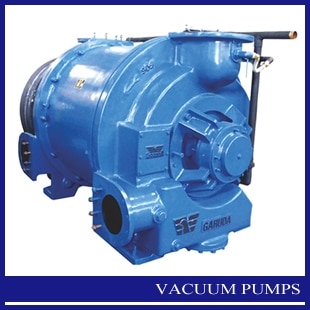:: Vacuum Pump, Water-ring Vacuum Pumps ::
Vacuum Pump Manufacturer, Supplier, and Exporter in India [GUJARAT]
Vacuum pumps from GARUDABRAND – Oil-free and sustainable
Determine oil-free vacuum pumps from GARUDABRAND – clean, efficient and extremely durable.
A vacuum pump is a device that removes gas molecules from a sealed space, creating a partial vacuum in the process. A vacuum pump’s job is to create a relative vacuum within a given capacity. We export & supply vacuumpump, vacuum pumps, water rings vacuum pump, oil seal rotary high vacuum pumps supplies all over India – Ahmedabad, Mumbai, Surat, Rajkot, Mehsana, Vadodara, Valsad, Bhopal etc.
Pumps are classified into three types based on their design:
Positive displacement pumps work by continually expanding a cavity, allowing gases to flow in, sealing the cavity, and exhausting it to the atmosphere. To knock gas molecules out of the chamber, momentum transfer pumps, also known as molecular pumps, use high-speed jets of dense fluid or high-speed revolving blades. Gases in a solid or adsorbed state are captured by entrapment pumps. Cryopumps, getters, and ion pumps are all examples of this.

For low vacuums, positive displacement pumps are the most effective. The most typical design for achieving high vacuums is to employ momentum transfer pumps in conjunction with one or two positive displacement pumps. The positive displacement pump serves two objectives in this design. Because momentum transfer pumps cannot start pumping at atmospheric pressures, it first creates a rough vacuum in the vessel to be evacuated before using the momentum transfer pump to achieve the high vacuum. Second, by emptying the pile of displaced molecules in the high vacuum pump to low vacuum, the positive displacement pump backs up the momentum transfer pump. To achieve ultrahigh vacuums, entrapment pumps can be used, although they require periodic regeneration of the surfaces that trap air molecules or ions. Due to this need, their available operational duration in low and high vacuums can be unacceptably short, limiting their employment to ultrahigh vacuums. Pumps also differ in terms of manufacturing tolerances, sealing materials, pressure, flow, admission or exclusion of oil vapour, service intervals, reliability, dust, chemical, and liquid tolerances, and vibration tolerance.
How to choose a vacuum pump?
When selecting a vacuum pump, various aspects must be considered. First and foremost, your selection should be tailored to your intended purpose, allowing you to pick the technology, lubrication, chemical resistance, vacuum level, and required flow rate.
The quality and target vacuum level should be the most important factors to consider when selecting a vacuum pump. A rough or low vacuum, a high vacuum, and an ultrahigh vacuum are the three forms of vacuum. The difference between the three is the scarcity of the number of molecules obtained, which is determined by residual gas pressure. The number of molecules per cm3 decreases as the pressure decreases. As a result, vacuum quality has improved.
We refer to:
| Vacuum type | Maximum pressure (in mbars) | Minimum pressure (in mbars) | Molecules per cm³ |
| Rough vacuum | 1 | 10-3 | 1016 – 1013 |
| High vacuum | 10-3 | 10-7 | 1013 – 109 |
| Ultrahigh vacuum | 10-7 | 10-12 | 109 – 104 |
Main points of Vacuum Pump:
- Vacuum level
- Lubrication
- Flow rate
- Maintenance
- Chemical compatibility
